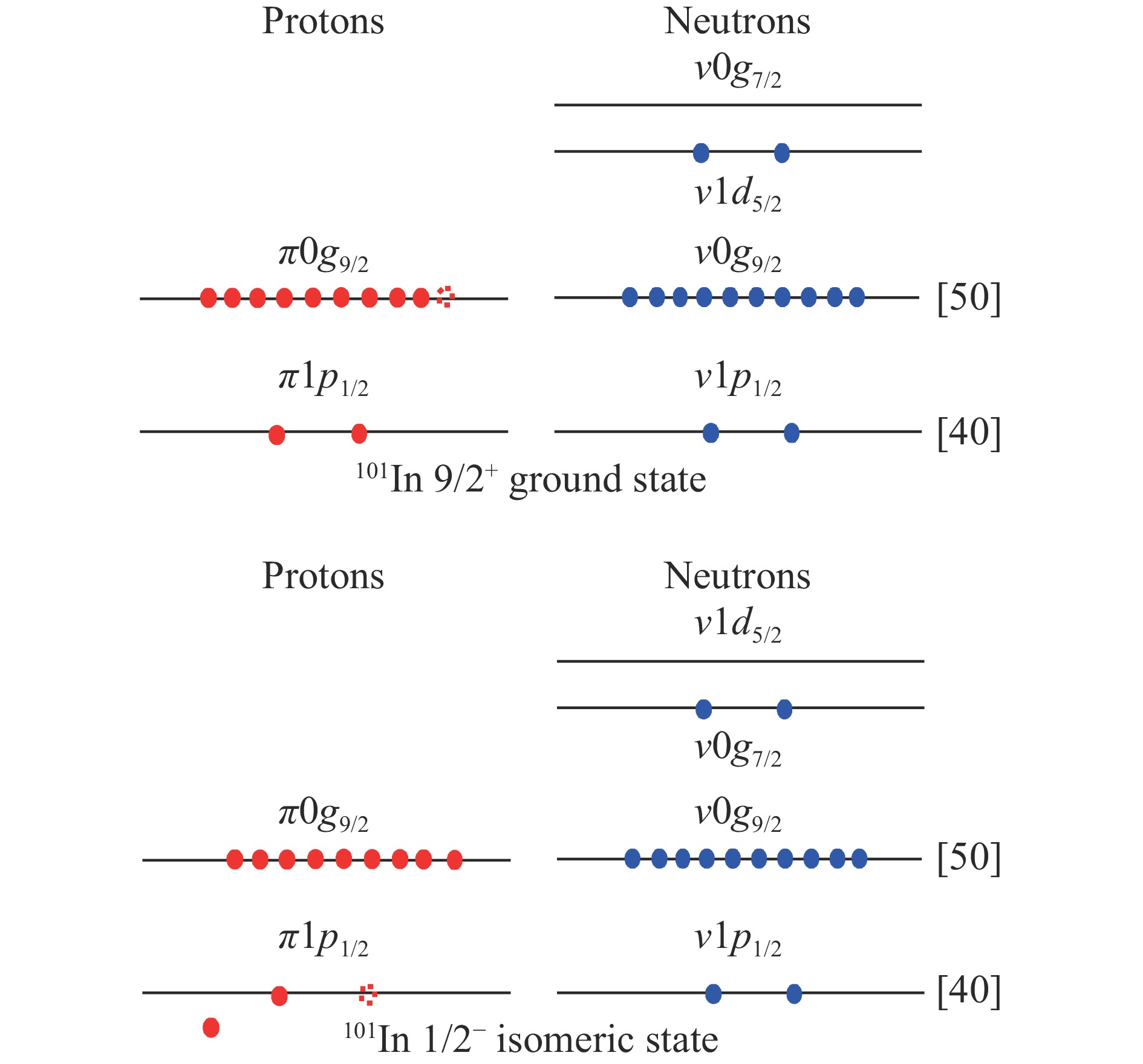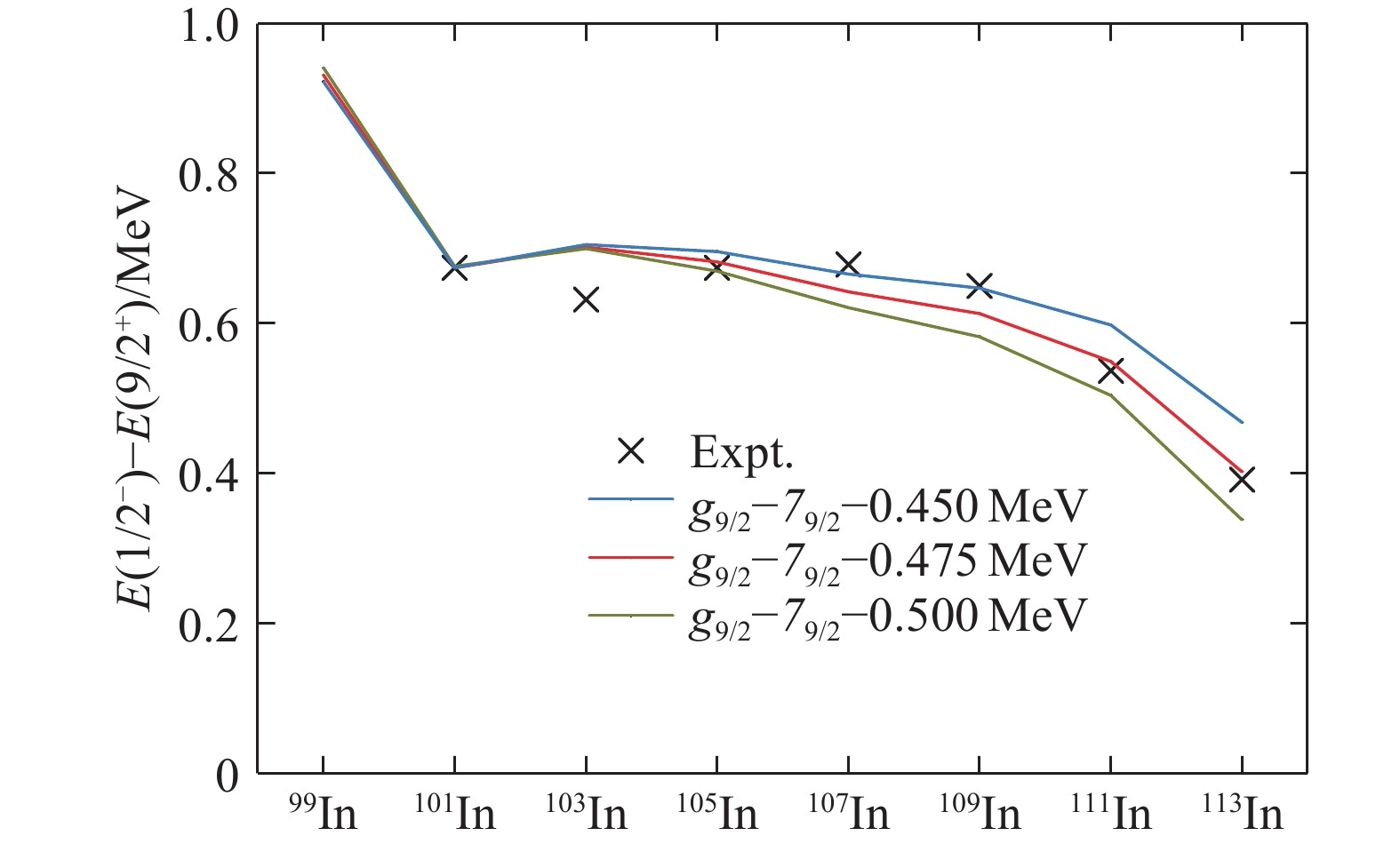
| Citation: | Cenxi YUAN, Menglan LIU, Yulin GE. Shell-Model Explanation on Some Newly Discovered Isomers[J]. Nuclear Physics Review, 2020, 37(3): 447-454. DOI: 10.11804/NuclPhysRev.37.2019CNPC18 |
Isomeric states are of great importance for nuclear structure investigations. For example, the isomeric states in nuclei around doubly magic nuclei, so called the shell-model isomers, often provide the first spectroscopic properties in the extreme neutron-rich and neutron-deficient nuclei in the medium and heavy mass region and include a plenty of information, such as the proton-neutron interaction and its role in shell evolution. Recent years, many isomeric states are newly discovered in extreme neutron-rich and neutron-deficient nuclei around doubly magic, 100Sn, 132Sn, and 208Pb. Because of relatively long half-lives, the properties of the isomeric states are easier to be observed and provide the first spectroscopic properties. Just in the year of 2019, discoveries on isomeric states are firstly reported in 101In[1], 123,125Ag[2], 134In[3], and 218Pa[4].
Fruitful discussions are made on the underlying physics behind the observed isomeric states. The strong neutron configuration mixing between the
In the present work, the nuclear shell model is used to provide more detailed investigations on the newly discovered isomeric states in 101In, 123,125Ag, and 218Pa, including Type I and II shell evolution and configuration mixing. A brief introduction is presented in Section 2 on the shell model and Hamiltonians used to investigate these isomeric states. The isomeric states in 101In, 123,125Ag, and 218Pa are discussed in Sections 3, 4, 5, respectively. The present work is concluded in Section 6.
The nuclear shell model solves the many body Schrodinger equations with the full considerations of the configuration mixing in a truncated model space. It provides nice descriptions on the spectroscopic properties of the atomic nuclei, such as the binding energies (relative to the core), the levels, the electromagnetic properties, the
The phenomenological nuclear force, the monopole based universal interaction
Encouraged by the nice performance of
The isomeric states of 218Pa and the
Recently, an isomeric
It should be noted that the shell evolution is generally induced by the proton-neutron interactions. As discussed in Ref. [13], the
On the other hand, the change of the proton configuration can induce the neutron shell evolution. A schematic picture is presented in Fig. 1 for the type II shell evolution in 101In. The two neutrons above the
Following above analysis, the excitation energies of the isomeric states in the odd-
Nuclei around the 132Sn region are of great interest because of their importance in both the fission products and the
It is of great interest to know whether the
As mentioned in Section 3, the
It is worth using the present Hamiltonian for the further investigations on the astrophysical interested
A
However, some facts from the observations and the shell-model calculations show deviations from such assumptions. Firstly, the excitation energies of the high spin isomers decrease from 210Bi to 216Ac. The newly discovered isomeric state in 218Pa has a larger excitation energy than that of 216Ac, which deviates from the systematic trend of the odd-odd
It is worth investigating further the mechanism which induces the evolution of the ground states and the isomeric states among
In summary, the newly discovered isomeric states in 101In, 123,125Ag, and 218Pa are well reproduced by the shell-model calculations, which provides a nice basis to investigate the underlying physics in these isomeric states.
The neutron configuration mixing is introduced to explain the similar excitation energies of the isomeric states in the odd-
The newly discovered isomeric states in 123,125Ag indicate the recovery of the
Based on the observed
It is expected that
Acknowledgement Prof. Zhang Yuhu, Prof. Wang Meng, Prof. Xu Xing, Prof. Yang Huabin, and Prof. Zhang Zhiyuan from the Institute of Modern Physics, CAS and Prof. Li Zhihuan, Prof. Hua Hui, and Dr. Chen Zhiqiang from Peking University are appreciated for their helpful discussions.
| [1] |
XU X, LIU J H, YUAN C X, et al. Phys Rev C, 2019, 100: 051303(R). DOI: 10.1103/PhysRevC.100.051303
|
| [2] |
CHEN Z Q, LI Z H, HUA H, et al. Phys Rev Lett, 2019, 122: 212502. DOI: 10.1103/PhysRevLett.122.212502
|
| [3] |
PHONG V H, LORUSSO G, DAVINSON T, et al. Phys Rev C, 2019, 100: 011302(R). DOI: 10.1103/PhysRevC.100.011302
|
| [4] |
ZHANG M M, YANG H B, GAN Z G, et al. Phys Lett B, 2020, 800: 135102. DOI: 10.1016/j.physletb.2019.135102
|
| [5] |
MOON B, MOON C B, DRACOULIS G D, et al. Phys Lett B, 2018, 782: 602. DOI: 10.1016/j.physletb.2018.06.008
|
| [6] |
MOON B, MOON C B, DRACOULIS G D, et al. Phys Rev C, 2019, 100: 024319. DOI: 10.1103/PhysRevC.100.024319
|
| [7] |
YUAN C X, LIU Z, XU F R, et al. Phys Lett B, 2016, 762: 237. DOI: 10.1016/j.physletb.2016.09.030
|
| [8] |
YUAN C X, QI C, XU F R, et al. Phys Rev C, 2014, 89: 044327. DOI: 10.1103/PhysRevC.89.044327
|
| [9] |
XU X X, LIN C J, SUN L J, et al. Phys Lett B, 2017, 766: 312; XU X X, LIN C J, SUN L J, et al. arXiv: 1610.08291.
|
| [10] |
LIANG P F, SUN L J, LEE J, et al. Phys Rev C, 2020, 101: 024305. DOI: 10.1103/PhysRevC.101.024305
|
| [11] |
SUN L J, XU X X, HOU S Q, et al. Phys Rev C, 2019, 99: 064312. DOI: 10.1103/PhysRevC.99.064312
|
| [12] |
SUN L J, XU X X, HOU S Q, et al. Phys Lett B, 2020, 802: 135213. DOI: 10.1016/j.physletb.2020.135213
|
| [13] |
OTSUKA T, SUZUKI T, HONMA M, et al. Phys Rev Lett, 2010, 104: 012501. DOI: 10.1103/PhysRevLett.104.012501
|
| [14] |
BERTSCH G, BORYSOWICZ J, MCMANUS H, et al. Nucl Phys A, 1977, 284: 399. DOI: 10.1016/0375-9474(77)90392-X
|
| [15] |
YUAN C X, SUZIKI T, OTSUKA T, et al. Phys Rev C, 2012, 85: 064324. DOI: 10.1103/PhysRevC.85.064324
|
| [16] |
YUAN C X. in preparation.
|
| [17] |
CHEN J, AURANEN K, AVILA M L. et al. Phys Rev C, 2019, 100: 064314. DOI: 10.1103/PhysRevC.100.064314
|
| [18] |
CHEN J, LOU J L, YE Y L, et al. Phys Lett B, 2018, 781: 412. DOI: 10.1016/j.physletb.2018.04.016
|
| [19] |
CHEN J, LOU J L, YE Y L, et al. Phys Rev C, 2018, 98: 014616. DOI: 10.1103/PhysRevC.98.014616
|
| [20] |
YUAN C X. Chin Phys C, 2017, 41(10): 104102. DOI: 10.1088/1674-1137/41/10/104102
|
| [21] |
XU Y P, PANG D Y, YUN X Y, et al. Phys Rev C, 2018, 98: 044622. DOI: 10.1103/PhysRevC.98.044622
|
| [22] |
XU Y P, PANG D Y, YUN X Y, et al. Phys Lett B, 2019, 790: 308. DOI: 10.1016/j.physletb.2019.01.034
|
| [23] |
YUAN C X, DU T X. Nucl Phys Rev, 2019, 35(4): 537. DOI: 10.11804/NuclPhysRev.35.04.537
|
| [24] |
YUAN C X, GE Y L, LIU M L, et al. Proceedings of the International Nuclear Data Conference, May 19-24, 2019[C]. Beijing, China, 2019.
|
| [25] |
WARBURTON E K, BROWN B A. Phys Rev C, 1991, 43: 602. DOI: 10.1103/PhysRevC.43.602
|
| [26] |
KUO T T S, HERLING G H. Report No. 2258[R].US Naval Research Laboraotory, 1971.
|
| [27] |
HERLING G H, KUO T T S. Nucl Phys A, 1972, 181: 113. DOI: 10.1016/0375-9474(72)90905-0
|
| [28] |
SHIMIZU N, MIZUSAKI T, UTSUNO Y, et al. Comput Phys Commun, 2019, 244: 372. DOI: 10.1016/j.cpc.2019.06.011
|
| [29] |
YUAN C X. Phys Rev C, 2016, 93: 034310. DOI: 10.1103/PhysRevC.93.034310
|
| [30] |
YUAN C X. Nucl Phys Rev, 2017, 34(1): 110. DOI: 10.11804/NuclPhysRev.34.01.110
|
| [31] |
YOSHIDA S, SHIMIZU N, TOGASHI T, et al. Phys Rev C, 2018, 98: 061301(R). DOI: 10.1103/PhysRevC.98.061301
|
| [32] |
NuDat[EB/OL].[2019-12-20].http://www.nndc.bnl.gov/nudat2/.
|
| [33] |
TSUNODA Y, OTSUKA T, SHIMIZU N, et al. Phys Rev C, 2014, 89: 031301(R). DOI: 10.1103/PhysRevC.89.031301
|
| [34] |
KREMER C, ASLANIDOU S, BASSAUER S, et al. Phys Rev Lett, 2016, 117: 172503. DOI: 10.1103/PhysRevLett.117.172503
|
| [35] |
MORALES A I, BENZONI G, WATANABE H, et al. Phys Lett B, 2017, 765: 328. DOI: 10.1016/j.physletb.2016.12.025
|
| [36] |
MOON B, MOON C B, SÖDERSTRÖM P A, et al. Phys Rev C, 2017, 95: 044322. DOI: 10.1103/PhysRevC.95.044322
|
| [37] |
MOON B, MOON C B, ODAHARA A, et al. Phys Rev C, 2017, 96: 014325. DOI: 10.1103/PhysRevC.96.014325
|
| [38] |
HAN R, LI X Q, JIANG W G, et al. Phys Lett B, 2017, 772: 529. DOI: 10.1016/j.physletb.2017.07.007
|
| [39] |
JIANG W G, HU B S, SUN Z H, et al. Phys Rev C, 2018, 98: 044320. DOI: 10.1103/PhysRevC.98.044320
|
